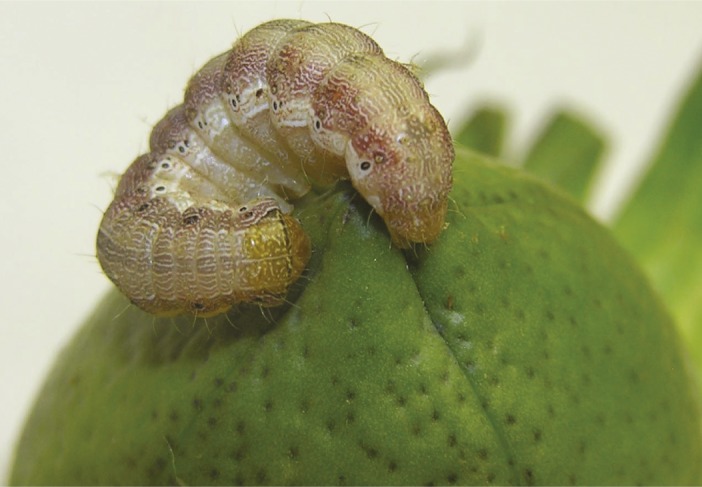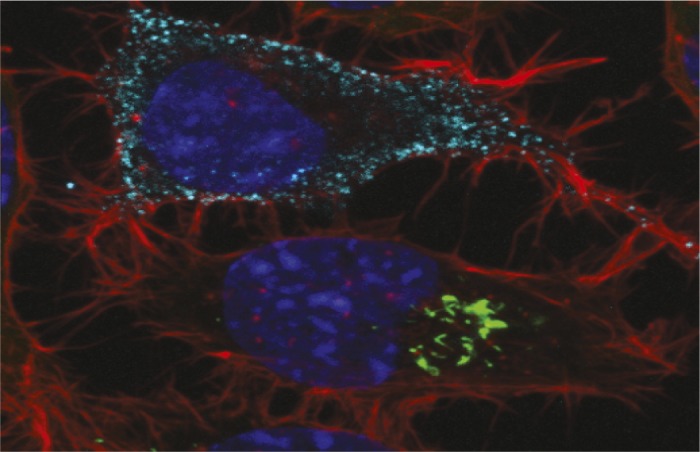Potential shortfall of common pest-control strategy

H. zea larva feeding on a cotton boll.
Transgenic crops are often engineered to produce two or more toxins that kill the same pest to minimize the evolution of resistant pests. To be effective, the strategy requires two-toxin plants to be able to kill insects resistant to only one of the toxins, a process called “redundant killing.” Thierry Brévault et al. (pp. 5806–5811) found that selecting a strain of a major pest, Helicoverpa zea, for resistance to Bacillus thuringiensis (Bt) toxin Cry1Ac increased the pest’s survival on transgenic cotton producing Bt toxins Cry1Ac and Cry2Ab relative to the unselected parent strain. The authors found a seasonal decline in the concentration of Cry2Ab in cotton plants that may have reduced levels of redundant killing of H. zea. The authors analyzed results of 21 selection experiments with 8 species of lepidopteran pests and found evidence of pervasive cross-resistance between Cry1A and Cry2A toxins. Simulations indicated that for pests such as H. zea that have low susceptibility to Bt toxins, cross-resistance between Cry1A and Cry2A or lack of redundant killing could lead to accelerated evolution of resistance to two-toxin plants. The authors suggest that some pest–Bt crop combinations may be less suitable than others for a two-toxin strategy and may require additional comprehensive pest control methods. — S.R.
Engineered yeast prion spreads between mammalian cells

Mouse neuroblastoma cell line with NM-HA prions (light blue: anti-HA antibody) in coculture with recipient cell line expressing NM-GFP.
Protein aggregates implicated in neurodegenerative diseases such as Alzheimer’s and Parkinson diseases have been shown to propagate through a mechanism similar to the spread of prions, infectious, self-replicating protein aggregates. Prions are found in fungi and mammals; whereas fungal prions replicate in the cells’ cytoplasm, the replication of mammalian prions has been long considered to be restricted to the cells’ plasma membrane and membrane-bound vesicles. To determine how fungal prions replicate in mammalian cells, Julia Hofmann et al. (pp. 5951–5956) used mouse neuroblastoma cells engineered to produce a portion of a yeast prion, called Sup35 NM, in the cells’ cytoplasm. The authors report that fibrils of the yeast prion domain triggered the self-replication of corresponding protein molecules in the mouse cells, and that the aggregates were faithfully transmitted to daughter cells upon cell division. More importantly, the authors found that Sup35 NM prions could exit mouse cells, enter neighboring cells through cell-to-cell contact in culture dishes, and trigger heritable conformational changes in the neighbor cells’ NM proteins, suggesting the infectious potential of an experimentally produced yeast prion in mouse cells. In addition, the NM prions also spread to neurons from astrocytes, cells that support the maintenance and function of neurons, suggesting that cell division might not be required to trigger cytoplasmic prions. According to the authors, the findings might help researchers better understand prion-like phenomena in human neurodegenerative diseases. — P.N.
How the human brain cues up actions
Despite the subjective impression that the conscious human mind initiates voluntary actions, studies show that the human brain signals the intention to move several seconds before conscious awareness of the decision. To determine whether a similar neural preparation also occurs for spontaneous, abstract decisions, such as whether to add or subtract, Chun Siong Soon et al. (pp. 6217–6222) examined brain function by using fMRI in 17 participants who performed a task that required them to decide whether to add or subtract two numbers, perform the calculation, and manually indicate the answer on a keypad. The task helped dissociate the participants’ decision to add or subtract from their decision to move their hands, ensuring that the neural signals represented task decision-making and not motor preparation. The authors found that activity in regions of medial frontopolar cortex and posterior cingulate/precuneus predicted decision outcomes 4 seconds before participants were conscious of their decision to add or subtract. The finding suggests that the human brain starts shaping spontaneous decisions even before the decisions enter conscious awareness, the authors suggest. According to the authors, the brain regions involved in the process also predict movement decisions, suggesting the presence of generic circuits involved in forming intentions for voluntary actions. — B.A.
Clues to an equine hepatitis mystery

Twilight, a thoroughbred mare stabled at Cornell University whose genome was the first horse genome to be sequenced. Twilight’s genome sequence served as a reference in the authors’ efforts to uncover the TDAV sequence in the serum of infected horses. Image courtesy of Doug Antczak (Baker Institute for Animal Health, College of Veterinary Medicine, Cornell University, Ithaca, NY).
For nearly a century, the cause of a potentially fatal form of equine hepatitis called Theiler disease has remained a mystery. The disease, which can trigger lethargy, anorexia, elevated blood levels of liver enzymes, jaundice, fever, blindness, and coma in horses, often follows a prophylactic measure: the administration of immune serum to horses exposed to certain toxins and pathogens. Sanjay Chandriani et al. (pp. 5752–5753) used a high-throughput DNA sequencing method and phylogenetic analysis to uncover a potential causal agent for Theiler disease during an outbreak on a horse farm. During the outbreak, 8 of 22 horses treated with equine serum–derived botulinum antitoxin developed hepatitis weeks after the treatment. The authors identified a previously unreported virus belonging to the Flaviviridae family, which includes human hepatitis C virus and yellow fever virus, in the serum of two of the most severely ill horses and in a batch of the prophylactic antitoxin given to the horses. Further, an epidemiological survey in three independent locations revealed that 8 of the 17 horses treated with an antitoxin preparation containing the virus, named Theiler disease-associated virus (TDAV), developed hepatitis, suggesting that TDAV might be a causal agent of the disease. Although the study does not conclusively establish TDAV as the cause of Theiler disease, it provides an epidemiological link between the virus and the disease, according to the authors. — P.N.
Personal attributes revealed through analysis of online behavior records

You are what you Like.
A growing number of human activities take place in digital environments, providing opportunities for predicting personal traits and attributes using digital records of behavior. Michal Kosinski et al. (pp. 5802–5805) developed a mathematical model to predict an individual’s traits and preferences based on 58,466 US Facebook users’ records of “Likes.” The authors trained the model using demographic information from the volunteers’ Facebook profiles and other traits, such as intelligence, personality, and satisfaction with life that were measured in online surveys and tests. The model accurately predicted study participants’ gender, ethnic origin, and sexual orientation, correctly identifying males and females in 93% of cases, African Americans and Caucasians in 95% of cases, and homosexual and heterosexual men in 88% of cases. The model also correctly classified more than 80% of cases of Democrats and Republicans as well as Christians and Muslims, but was less accurate at predicting relationship status, substance abuse, and parents’ relationship status. The authors further found that the model was nearly as accurate as a personality test for predicting a user’s degree of openness to experience. The findings may be useful for improving the delivery of numerous products and services, but may also have negative implications for personal privacy, according to the authors. — N.Z.
Health effects of loneliness and social isolation
Both social isolation and loneliness increase the risk of heart disease, high blood pressure, inflammation, and death, though whether these factors act together or separately to impair health remains unclear. Andrew Steptoe et al. (pp. 5797–5801) tease apart the effects of loneliness and social isolation by exploring how each condition influences the risk of death. The authors studied 6,500 men and women aged 52 and older who participated in the English Longitudinal Study of Aging in 2004–2005, and assessed the individuals’ risk of death through March 2012. Limited contact with family, friends, and community organizations meant that a participant was classified as socially isolated, and a questionnaire was used to measure loneliness. The authors report that social isolation and loneliness both predict an early death. But while social isolation foretells death regardless of the participants’ health and demographic characteristics, the link between loneliness and death is limited to participants with underlying mental or physical concerns. According to the authors, the findings reveal that social isolation acts independently of loneliness to undermine health. The study suggests that while elderly people might benefit from strategies that combat both social isolation and loneliness, interventions that encourage social interactions might promote longevity, according to the authors. — A.G.


